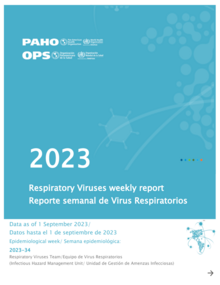North America: Influenza activity has remained at low levels. Over the past 4 epidemiological weeks (EW), the predominant influenza viruses have been influenza A(H1N1)pdm09, with concurrent circulation of influenza B/Victoria. Respiratory syncytial virus (RSV) activity has remained at low levels. SARS-CoV-2 activity has shown an increase over the last 4 EWs and continues to circulate at moderate levels. Cases of influenza-like illness (ILI) and severe acute respiratory infections (SARI) have increased, with a rising proportion of cases testing positive for SARS-CoV-2.
Caribbean: Influenza activity continues to exhibit a declining trend over the past 4 EWs. During this period, the predominant influenza viruses have been B/Victoria, with lesser circulation of influenza A, primarily A(H1N1)pdm09. RSV activity has remained low. SARS-CoV-2 activity shows an increasing trend with intermediate to high levels of circulation. ILI and SARI cases have demonstrated a declining trend over the past 4 EWs.
Central America: Influenza activity continues to decrease over the past 4 EWs. During this period, the predominant influenza viruses have been influenza B/Victoria, with concurrent circulation of influenza A, mainly A(H1N1)pdm09, and to a lesser extent, influenza A(H3N2). RSV activity has shown a decrease in the last EWs but remains at medium-high levels of circulation. SARS-CoV-2 activity is at low levels with a declining trend. ILI activity has remained low. SARI activity is currently decreasing; however, the proportion of cases attributable to RSV continues to rise. In El Salvador, RSV activity remains high, coinciding with an increase in SARS-CoV-2 circulation. In Guatemala, RSV activity continues at moderate-high levels, with elevated ILI activity and epidemic levels of SARI cases, with most ILI cases testing positive for RSV and influenza, and most SARI cases testing positive for RSV. In Honduras, influenza activity continues to decrease, and SARS-CoV-2 activity is at high levels. SARI cases are currently decreasing below the epidemic threshold, with almost all positives related to influenza. In Nicaragua and Panama, following moderate activity levels in previous EWs, influenza positivity in both countries is currently at epidemic levels. In Panama, RSV activity is at moderate levels.
Andean: Influenza activity remains stable at low levels. Over the past 4 EWs, the predominant influenza viruses have been influenza A, mainly A(H1N1)pdm09, and influenza B/Victoria. RSV activity remains at low levels. SARS-CoV-2 has shown a decline over the last 4 EWs, circulating at moderate levels, with elevated circulation in Bolivia. SARI activity continues to decline, with most cases associated with influenza and, to a lesser extent, RSV and SARS-CoV-2. ILI activity has shown a declining trend, with most cases associated with influenza.
Brazil and Southern Cone: Influenza activity has decreased to low circulation levels. Over the past 4 EWs, the predominant influenza viruses have primarily been A(H1N1)pdm09, with concurrent circulation of influenza B/Victoria. RSV activity has declined in the last 4 EWs, reaching low circulation levels. SARS-CoV-2 activity has increased, although it remains low. SARI activity has continued to decline over the past 4 EWs, with most cases testing positive for RSV. ILI cases have shown a slight increase, with low positivity percentages for the monitored respiratory viruses. Argentina continues to present epidemic levels of influenza activity, with the majority of cases testing positive for influenza A(H1N1)pdm09. SARS-CoV-2 activity has increased to moderate levels, but ILI and SARI levels remain below the epidemic threshold. In Brazil, influenza activity is decreasing, while SARS-CoV-2 is on the rise, with SARI levels above the epidemic threshold. In Chile, ILI activity remains at moderate levels, showing a slight increase, with most cases related to influenza. SARI activity is currently decreasing below the epidemic threshold. In Paraguay, SARI activity has declined, reaching epidemic levels, with RSV being the primary cause among positive cases. In Uruguay, SARI activity has decreased over the past EWs, with most cases associated with RSV.
|

